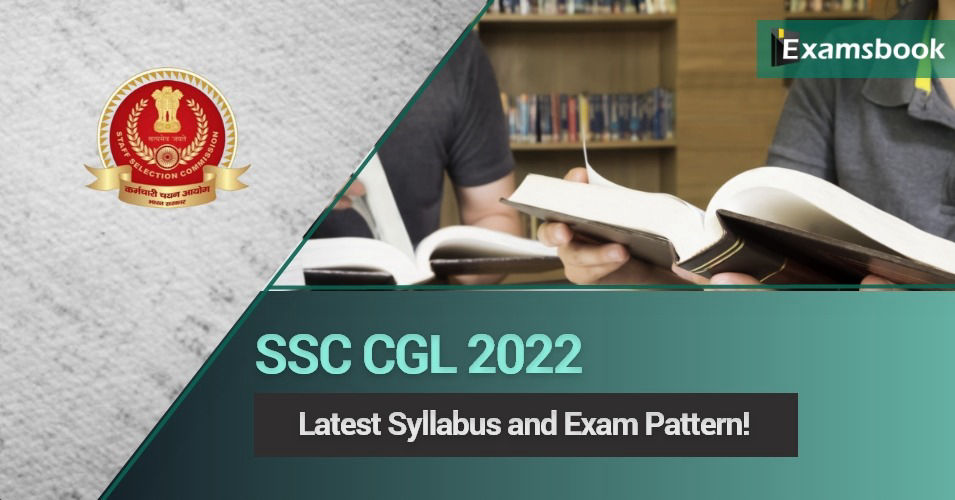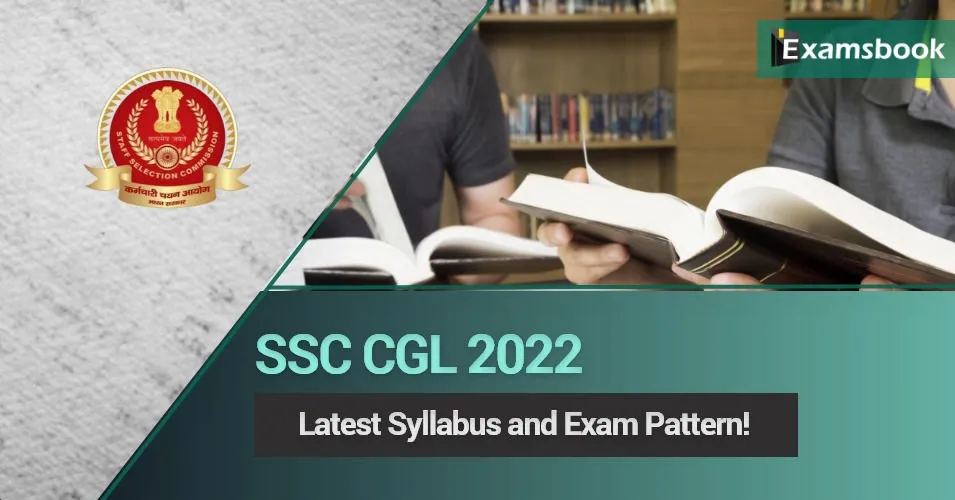


Hello Friends,
Do you know? SSC CGL Syllabus 2022 is changed now.
On 17th September 2022, the Staff Selection Commission (SSC) announced an SSC CGL Recruitment 2022 for filling up approx 20000 for Group' B' and Group' C' posts by issuing the latest notification.
Furthermore, SSC has made a big change in its SSC CGL syllabus while releasing the SSC CGL notification 2022 this year. SSC CGL Tier 1 exam is scheduled to be conducted in December 2022. Candidates planning to prepare for the SSC CGL Exam 2022 must first go through the latest SSC CGL syllabus and exam pattern.
In the SSC CGL Latest Syllabus, Tier 1 and Tier 2 are compulsorily included. We have discussed the exam pattern and syllabus for each SSC CGL Stage for your convenience in this article.
Based on the new pattern, let's understand the SSC CGL Syllabus 2022 for Tier I & II exams.
Candidates can notice the new SSC CGL Tier 1 Exam Pattern and Syllabus same as the Old SSC CGL syllabus . Tier 2 can create some confusion in your mind, therefore we will try to explain it perfectly here. Check out the complete details about all the tier-1 & 2 exams below.
|
S.No. |
Subject |
No. of Questions |
Marks |
Time |
|
1 |
General Intelligence |
25 |
50 |
60 Minutes (For VH and Suffering from cerebral palsy: 80 Minutes) |
|
2. |
General Awareness |
25 |
50 | |
|
3. |
Quantitative Aptitude |
25 |
50 | |
|
4. |
English comprehension |
25 |
50 |
After completing the preliminary exam, it will be necessary to undergo Tier-2 of the SSC CGL 2022 Exam. Except for Module-II (Data Entry Speed Test) of Section-III of Paper-I, the Mains Exam is an objective multiple-choice online exam.
| Paper | Session | Section | No. of question | Maximum
Marks |
Duration |
| Paper I | Session I (2 hours 15 Minutes)
|
Section I:
Module I: Mathematical Module I: Reasoning and General Intelligence |
30 30 Total= 60 |
60*3= 180 | 1 hour
(for each section) (1 hours and 20 minutes for the candidates eligible for scribe) |
| Section II:
Module I: English Language and Comprehension Module II: General Awareness |
45 25 Total =70 |
70* 3= 210 | |||
| Section III:
Module I: Computer Knowledge Module |
20 |
20*3 =60 | 15 Minutes (for each module) (20 minutes for the candidates eligible for scribe) | ||
| Session II (15 Minutes) | Section III:
Module II: Data Entry Speed Test Module |
One Data
Entry Task |
— | ||
| Paper II | Statistics | 100 | 100*2= 200 | 2 hours (2 hours and 40 minutes for the candidates eligible for scribe) | |
| Paper III | General Studies (Finance and Economics) | 100 | 100*2= 200 | 2 hours (2 hours and 40 minutes for the candidates eligible for scribe) | |
Don't forget to practice with the help of SSC CGL Test Series 2022 for Tier I & II.
According to the instructions of the selection process by the Commission, candidates will need to participate in the document verification. Also, physical testing and medical standards will also be valid for passing some posts such as Inspector (Central Excise)-CBIC, Inspector (Examiner)-CBIC, Inspector (Preventive Officer)-CBIC, Inspector-CBN, Sub-Inspector-CBN, Ministry of Finance, more.
The SSC CGL syllabus is split into two phases, commonly known as Tier – I and Tier- II. Tier 1 and Tier 2 of the SSC CGL 2022 are conducted online. The SSC CGL Tier 1 exam is qualifying, whereas the final selection is based on the SSC CGL Tier 2 Exam. The detailed Latest SSC CGL syllabus is explained below:
SSC CGL Tier 1 has four sections in the prescribed syllabus. The exam sections are Quantitative Aptitude, General Intelligence and Reasoning, English, and General Awareness. You will learn the precise SSC CGL Tier 1 exam syllabus here.
The SSC CGL Tier 2 is divided into three sections: Paper 1, Paper 2 & Paper 3. In Paper 1, there will be 4 subjects: Quantitative Ability, General Intelligence & Reasoning, General Awareness, and English Language & Comprehension.
Those who have applied for Junior Statistical Officer (JSO) and Assistant Audit Officer/ Assistant Accounts Officer will be eligible to appear for Paper 2 & 3, respectively. Scroll down ↴
To test comprehension, three or more paragraphs will be given and questions based on those will be asked. At least one paragraph should be a simple one based on a book or a story and the other two paragraphs should be on current affairs, based on a report or an editorial.
Computer Basics: Organization of a computer, Central Processing Unit (CPU), Input/ Output devices, computer memory, memory organization, back- up devices, PORTs, Windows Explorer. Keyboard shortcuts.
Software: Windows Operating system including basics of Microsoft Office like MS word, MS Excel and Power Point etc.
Working with Internet and e-mails: Web Browsing & Searching, Downloading & Uploading, Managing an E-mail Account, e-Banking
Basics of networking and cyber security: Networking devices and protocols, Network and information security threats (like hacking, virus, worms, Trojan etc.) and preventive measures.
1. Collection, Classification and Presentation of Statistical Data –Primary and Secondary data, Methods of data collection; Tabulation of data; Graphs and charts; Frequency distributions; Diagrammatic presentation of frequency distributions.
2. Measures of Central Tendency – Common measures of central tendency – mean median and mode; Partition values- quartiles, deciles, percentiles.
3. Measures of Dispersion- Common measures dispersion – range, quartile deviations, mean deviation and standard deviation; Measures of relative dispersion.
4. Moments, Skewness and Kurtosis – Different types of moments and their relationship; meaning of skewness and kurtosis; different measures of skewness and kurtosis.
5. Correlation and Regression – Scatter diagram; simple correlation coefficient; simple regression lines; Spearman’s rank correlation; Measures of association of attributes; Multiple regression; Multiple and partial correlation (For three variables only).
6. Probability Theory – Meaning of probability; Different definitions of probability; Conditional probability; Compound probability; Independent events; Bayes‟ theorem.
7. Random Variable and Probability Distributions – Random variable; Probability functions; Expectation and Variance of a random variable; Higher moments of a random variable; Binomial, Poisson, Normal and Exponential distributions; Joint distribution of two random variable (discrete).
8. Sampling Theory – Concept of population and sample; Parameter and statistic, Sampling and non-sampling errors; Probability and nonprobability sampling techniques(simple random sampling, stratified sampling, multistage sampling, multiphase sampling, cluster sampling, systematic sampling, purposive sampling, convenience sampling and quota sampling); Sampling distribution(statement only); Sample size decisions.
9. Statistical Inference – Point estimation and interval estimation, Properties of a good estimator, Methods of estimation (Moments method, Maximum likelihood method, Least squares method), Testing of hypothesis, Basic concept of testing, Small sample and large sample tests, Tests based on Z, t, Chi-square and F statistic, Confidence intervals.
10. Analysis of Variance – Analysis of one-way classified data and two-way classified data.
11. Time Series Analysis – Components of time series, Determinations of trend component by different methods, Measurement of seasonal variation by different methods.
12. Index Numbers – Meaning of Index Numbers, Problems in the construction of index numbers, Types of an index number, Different formulae, Base shifting and splicing of index numbers, Cost of living Index Numbers, Uses of Index Numbers.
This section of the SSC CGL Tier 2 Syllabus is divided into 2 parts Finance & Accounts and Economics & Governance for which the sub-topics are detailed below-
Part A: Finance and Accounts-(80 marks):
1.1 Financial Accounting
1.2 Basic concepts of accounting
Part B: Economics and Governance-(120 marks):
2.1 Comptroller & Auditor General of India- Constitutional provisions, Role and responsibility.
2.2 Finance Commission-Role and functions.
2.3 Basic Concept of Economics and introduction to Micro Economics
2.4 Theory of Demand and Supply
2.5 Theory of Production and cost
2.6 Forms of Market and price determination in different markets
2.7 Indian Economy:
2.8 Economic Reforms in India
2.9 Money and Banking:
2.10 Role of Information Technology in Governance.
Note: Questions in Module-I of Section- I of Paper-I (Mathematical Abilities) will be of Matriculation Level, in Module-I of Section- II of Paper-I (English Language and Comprehension) of 10+2 Level and in Paper-II and Paper-III of Graduation Level.
Q. What is the last date of SSC CGL Recruitment 2022?
Ans. Aspirants can apply online for SSC CGL Recruitment 2022 till 09 October 2022.
Q. Does the SSC CGL Syllabus change every year by SSC?
Ans. No, SSC CGL syllabus does not change very often. This year, the commission has changed the SSC CGL exam pattern a bit, but the subjects of SSC CGL Syllabus are yet same.
Q. Is there a negative marking in SSC CGL Exam?
Ans. Yes, there is a negative marking of 0.50 mark in Tier I and in Tier II.
Q. How can I prepare the SSC CGL syllabus in 2 Months?
Ans. It will be difficult. But being a student; you must try by following this - How to Prepare for Competitive Exam in 2 Months – Weekly Study Plan!
Sharing is caring!
Get the Examsbook Prep App Today